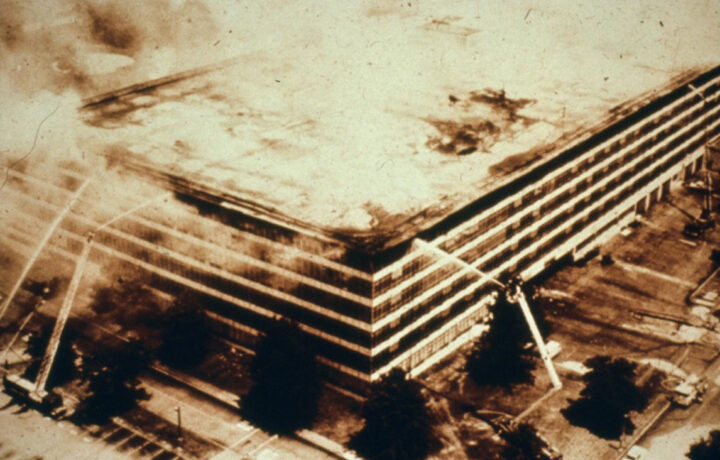On the morning of July 12, 1973, a devastating fire broke out on the sixth floor of the National Personnel Records Center in St. Louis, MO. By the time firefighters extinguished the blaze, over 16 million official military personnel files had been destroyed. This catastrophic event not only damaged the federal government’s ability to account for service members’ histories but has also had lasting consequences for veterans, their families, and historians ever since.
What Was Lost?
According to a VA news article, the fire primarily destroyed records of U.S. Army personnel discharged between 1912 and 1960, and U.S. Air Force personnel discharged between 1947 and 1964. The files were stored mainly in cardboard boxes on the sixth and top floor of the building. The NPRC served as the primary archive for military records, making it the sole custodian for many of these files. At the time, there were no duplicate records, no microfilm backups, and no digital copies. The fire wiped out approximately:
- 80% of Army personnel records from 1912 to 1960
- 75% of Air Force personnel records from 1947–1964 (with surnames alphabetized from Hubbard through Z)
For many veterans and their descendants, this meant the complete loss of documentation needed for proving service. This led to a complete inability to apply for VA benefits or research family military history.
The Fire’s Origin and Aftermath
The cause of the fire remains officially undetermined to this day. No sprinkler systems were in place at the time, and the building’s design, which was a vast open floor, was filled with flammable paper records. This allowed the fire to spread uncontrollably. The boxes, which held the records were reportedly completely full. Also, the boxes were so tightly packed into the storage area that when the fire broke out, it burned intensely and completely out of control. It took over 40 fire departments more than two days to shut down the blaze.
The National Archives and Records Administration launched immediate recovery efforts. Efforts included drying water-damaged documents and using new conservation techniques to salvage partially burned files. Still, the magnitude of the destruction meant that many records were lost forever. In some cases, only fragments were recovered. Reconstruction efforts began shortly after the fire, relying on alternative documents like pay vouchers, unit rosters, morning reports, and hospital admission records to rebuild service histories.
Long-Term Impact
For veterans applying for benefits, the missing records created barriers that persist to this day. The VA and NPRC developed protocols allowing veterans to submit affidavits, alternate documentation, or statements from fellow service members as substitutes for lost records. However, this placed the burden on veterans to prove their service, often decades after it occurred.
For historians and genealogists, the fire created a permanent gap in the nation’s military archives. It also underscored the importance of digital archiving and led to a major shift in how federal agencies preserve essential documents. The VA has also called upon the families of those veterans with complete records. Those families could fill out a request form that would allow their documentation to become searchable to help ‘fill in gaps’.
According to the VA, when it comes to those who served during the affected era’s, ‘[they] will accept, as alternate sources for records, statements from service medical personnel, certified “buddy” statements or affidavits, accident and police reports, Employment-related examination reports, letters written during service, photographs taken during service, pharmacy prescription records, insurance-related examination reports, medical evidence from civilian/private hospitals, clinics, and physicians that treated you during service or shortly after separation, and photocopies of any service treatment records that you may have in your possession.’
Modern Lessons and Continuing Recovery
Today, the National Archives continues to respond to requests for records affected by the 1973 fire. Affected veterans are often eligible for “reconstructed records packages” using available sources. Since the fire, the NPRC has embraced digital preservation. Together, the Department of Defense and the VA are working to ensure that military service records are now electronically stored and more secure from future loss.
The fire serves as a reminder of the fragility of physical records and the importance of proactive record-keeping, both at the national level and for individuals. Veterans are now encouraged to maintain personal copies of their DD-214 and other vital documents. The 1973 fire may have claimed millions of records, but it also lit a fire under modern archival reform.




